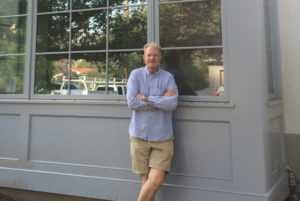Source: thelightingresource.eaton.com
Published: January 12, 2017

Actor-director Ed Begley Jr. earned six Emmy nominations for his work on the hit series “St. Elsewhere” and has starred in hundreds of feature films, television series and theater productions. But he is almost as famous for his environmental leadership. Begley bought his first electric car in 1970 and is known for riding his bicycle to Hollywood events.
The Eaton’s Lighting Division team talked with Begley, who is building a new home under LEED Platinum Certified standards, about the sustainable living movement and what makes LED lighting so green.
Sustainability is no longer a buzz word – for many people, it’s part of everyday life. How long has it been part of the lighting conversation?
Sustainability became part of the lighting conversation when dimmers hit the market. Previously, we’d put in a light bulb and live with 75 watts of light. But dimmers allowed us to use a fraction of the electricity while still illuminating the space. With this change, people began to understand that they could have more pleasant lighting and save money, too.
Then, light bulbs began to change. First, we moved to CFLs. Now, LEDs are becoming more popular. Most people appreciate that light can be energy-efficient and attractive. We’ve come a long way from the blue glare of early LEDs. Today, they can provide warm, pleasing light. The industry has become skilled at making it attractive.
What are some of the factors driving sustainable efforts in lighting?
As clean air laws are enacted, people are beginning to understand sustainability isn’t free. Someone has to cover the cost of combating climate change. But if you can make your lighting more efficient, you can save more money in the long run. Making sustainable choices eases our reliance on vast amounts of centralized power generated by power plants. Sustainable lighting helps us turn to alternatives such as solar power.
Power generation is going to continue to grow more costly, so the more we can do to reduce our power consumption, the better. Sustainable lighting helps us achieve that goal.
Why is it so important to live a sustainable lifestyle?
We have to do our part to combat climate change. I got my first electric car in 1970—before we even knew about climate change—and I’ve been fighting it ever since. Back then, I only wanted to clean up the air in Los Angeles.
For years, people have questioned the ROI of sustainability efforts. If you’re in something for the long haul, sustainable practices represent a valuable investment that will extend the life of a building. Many people believe a structure’s cost equals the cost of construction, but that’s only the tip of the iceberg. It doesn’t include the cost of running the building. Efficient lighting is just one way to reduce the cost of operations for the long haul. And if you build the building in a sustainable way, it will last for decades or even hundreds of years.
When it comes to lighting, what are specific ways to conserve energy?
Choosing lighting wisely is essential. For years, I promoted CFLs, because they were inexpensive and saved electricity compared to available alternatives. Today, I urge people to use LEDs, because the costs have come down significantly.
Once you’ve chosen your light source, it’s important to incorporate dimming and other lighting controls technologies. My home includes a fantastic system of efficient LEDs with built-in dimming controls.
Aside from pure energy costs, maintenance costs are another way LEDs equal savings. A lot of people don’t realize this. In industrial and commercial operations, getting someone up to the ceiling of a warehouse to replace light bulbs that have burned out is an expensive proposition. But because LEDs last so much longer, service calls aren’t needed nearly as often.
What are some of the most exciting advancements and trends in this space?
Not so long ago, it was difficult to dim LEDs, and the color and quality of the light were not what I’d call inviting. At first, my wife didn’t want LEDs in our home. But the lighting industry has made incredible strides, and once I showed my wife the new generation, she was 100 percent on-board. Today’s LEDs are easily dimmable and can provide a nice, warm light.
The controls are probably the most exciting space in the lighting industry today. I can control my lights from my smartphone and touchpads throughout the house. I have lots of different lighting modes and smart shades that go up and down at different times of day.
Lighting controls have come such a long way, it’s as if we’re living in a whole new world – and you don’t have to be tech-savvy to harness their power.
At the end of the day, LED lighting is one of the best, most “bang for your buck” ways to be green. I love my solar panels, but they were expensive and required a home energy audit. If you care about our planet and want to take the biggest, quickest bite of the apple, LEDs are a great way to do it.
